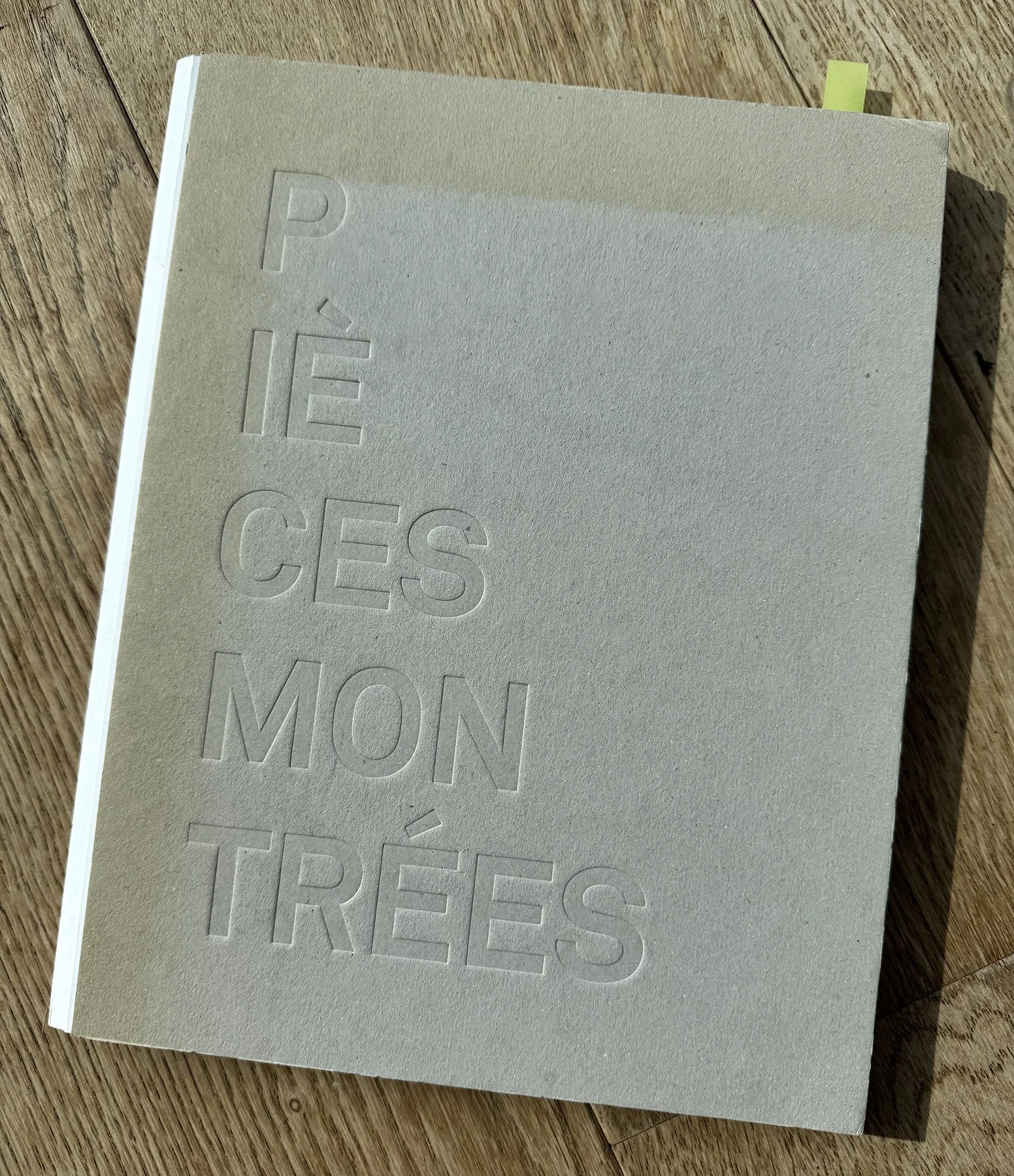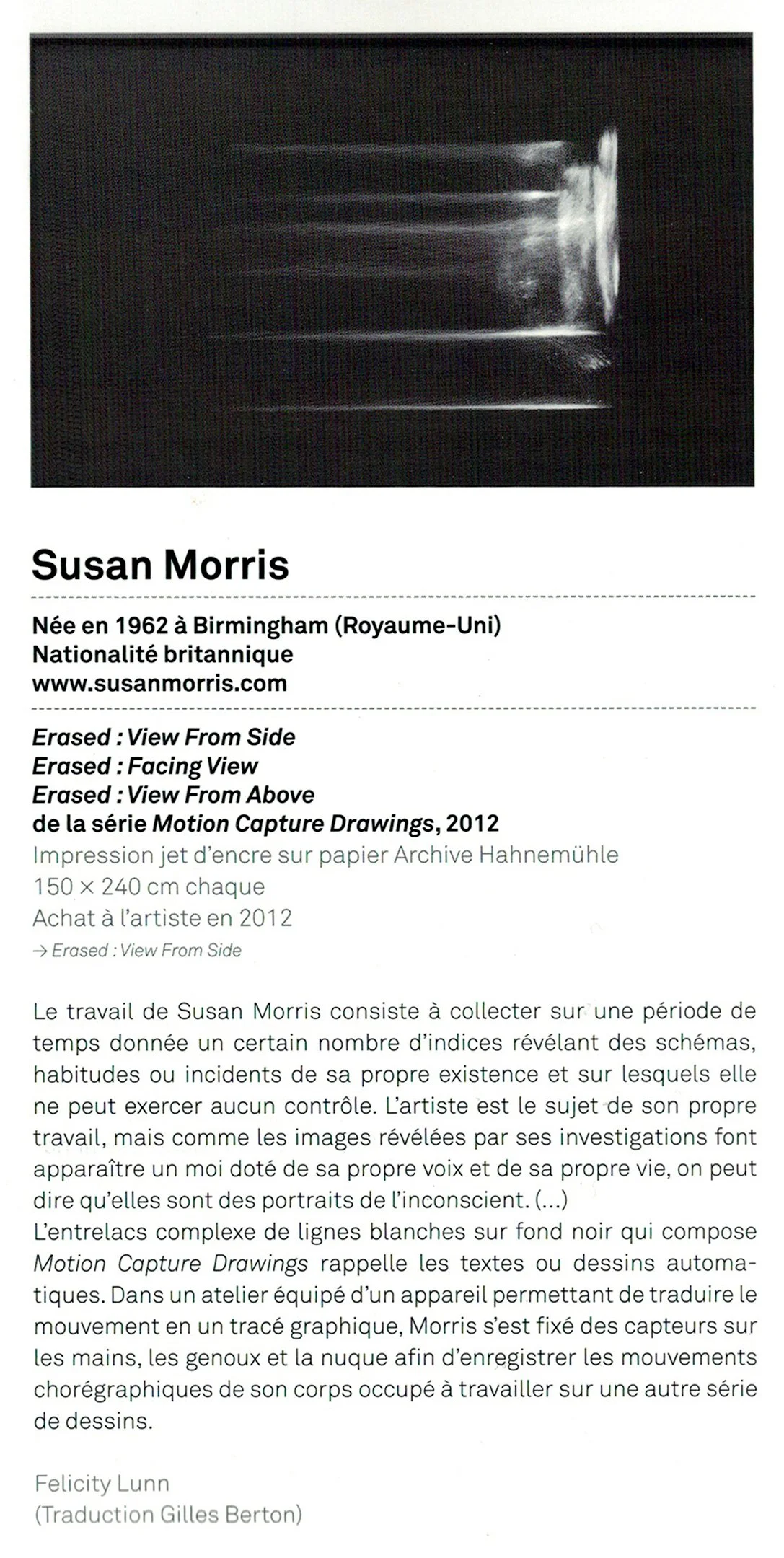THE IMPOSSIBLE COLLECTION
Foundation Fernet-Branca, Saint-Louis, France
20th October 2013 - 23rd March 2014
For further details on the motion capture work, please see ‘Drawing in the Dark’, Tate Papers #18, 2012
EXTRACT FROM EXHIBITION BROCHURE
La Collection impossible
FRAC Alsace: 30 years of Collecting.
Roland Recht, Olivier Grasser
Introduction
This exhibition borrows its name from a short story by the Viennese writer Stefan Zweig (1881-1942). During World War One, there being not much on the market, an art dealer who has been a victim of the economic crisis, goes in search of pieces to buy from a famous collector who has accumulated a veritable museum of prints.
But the collector - who has lost his sight - is ignorant of the fact that his wife and daughter have already sold his stock in order to provide for their day to day needs. Instead the poor man proceeds to give a particularly heartfelt description of the succession of blank pages the two women have substituted for his treasures.
The title given to the FRAC Alsace collection does not refer to an invisible or absent collection but rather calls for a reassessment of the idea of collecting, designating works of art that compliment each other through their heterogeneity as well as encompassing several pieces from other collections.
«La Collection Impossible» is the largest of the four parts of the exhibition «Pieces Montrées»:30 Years of Collecting. Free from chronological concerns, the method doesn’t follow a strict protocol or scientific method . The Regional Art fund aims to encourage artistic sensibility and promote education. Through their choices, the curators have privileged a mix of subjective as well as more rational criteria in order to point out themes and underlying issues and open a dialogue with the public about the nature of contemporary practices.
Exceptional works of art have been selected for this exhibition. The quality of the space allowing for the display of works that would otherwise be rarely seen. In light of a difficult task the curators have privileged a sensitive approach, subtly and successfully presenting the FRAC Alsace collection as a history of taste in the past thirty years.
Room 9
...moving on from Nely Massera's video depicting a sensual, intriguing, nocturnal place, the following room is dominated by darkness and silence.
Opposite a self-portrait by Gerd Bonfert characterized by subtle play of light, three large works by Susan Morris first appear like abstract Expressionist paintings. Her marks in fact correspond to the mechanical recording of her movements. The British artist's entire body of work is concerned with the revision of aesthetic codes of painting. Juxtaposing seemingly mundane or personal textual elements, the nature of the image itself is called into question as the making process becomes further entwined within it.
In the middle of the room, the sculpture “500 metres of silence” by Mounir Fatmi is a critical statement on loneliness in modern societies despite the advancements in communication technology.
TRANSLATION BY ANTHONY ROBINSON
IMPOSSIBLE - gallery info
CATALOGUE PIECE MONTRES IMPOSSIBLE
Susan Morris's work consists of collecting, over a given period of time, a certain number of clues revealing patterns, habits, or incidents in her own life over which she has no control. The artist is the subject of her own work, but since the images revealed by her investigations reveal a self with its own voice and life, they can be said to be portraits of the unconscious. (...) The complex interlacing of white lines on a black background that composes Motion Capture Drawings is reminiscent of automatic texts or drawings. In a studio equipped with a device that translates movement into a graphic trace, Morris attached sensors to her hands, knees, and neck to record the choreographic movements of her body as she worked on another series of drawings. Felicity Lunn
PRESS - EXTRACT from Dossier de presse Pièces Montrées
« La Collection Impossible »
In 2013, the FRACs (French regional contemporary art collections) are celebrating their 30th anniversary. This anniversary is a chance for FRACs all over France to assert their presence and their missions through specific events, not only in the regional context but also at national and international levels. A part of this programme is a wide-ranging, institutionally orientated exhibition being held concurrently over 4 sites under the title Pièces Montrées – FRAC Alsace, 30 years of Collecting. It has been put together from the FRAC collection and is being presented at the Chapelle des Annonciades / Historical Museum Haguenau, the MAMCS Strasbourg (Modern and Contemporary Art Museum), the Frac Alsace Sélestat and the Fernet-Branca Foundation in Saint-Louis.
The Fernet-Branca Foundation site, the largest in the exhibition, has the advantage of providing a choice from the FRAC collection that is both far-reaching and complex. It has been organized by Roland Recht, honorary director of the Strasbourg museums, professor at the Collège de France and member of the Institut de France, in tandem with Olivier Grasser. Roland Recht is a historian and specialist in medieval art, but he has for long shown a deep interest in modern and present-day creation, having staged notable exhibitions over the last thirty years and been an active critic, with the eye of a cultivated connoisseur and the mind of a humanist, on the contemporary art scene.
Œuvres de : Ziad Antar, John Armleder, Marc Bauer, Gerd Bonfert, Jean-Baptiste Bruant, Frédéric Lormeau, Maria Spangaro, Balthasar Burkhard, Jean-Marc Bustamante, Damien Cabanes, Chen Zhen, David Claerbout, Clément Cogitore, Didier Courbot, Stéphane Couturier, Bill Culbert, Christophe Cuzin, Marcel Dinahet, Hubert Duprat, Jan Fabre, mounir fatmi, Jean-Louis Faure, Pierre Filliquet, Gregory Forstner, Maïder Fortuné, Vidya Gastaldon, Sylvain Gouraud, Thomas Hirschhorn, Valérie Jouve, Naji Kamouche, Jan Kopp, Marcus Kreiss, Ange Leccia, Philippe Lepeut, Andrew Lewis, Fabian Marti, Charles Mason, Nelly Massera, Olga Mesa et Francisco Ruiz de Infante, Henri Michaux, Anita Molinero, Richard Monnier, Susan Morris, Patrick Neu, Walter Niedermayr, Astrid Nippoldt, Panamarenko, Gaetano Pesce, Fernande Petitdemange, Étienne Pressager, Marie Prunier, Bernard Quesniaux, Sophie Ristelhueber, Didier Rittener, Peter Rösel, Jean-Michel Sanejouand, Daniel Schlier, Kristina Solomoukha, Gerda Steiner & Jörg Lenzlinger, Josef Sudek, Benjamin Swaim, Stéphane Thidet, Stefanos Tsivopoulos, Cy Twombly, Petra Werlé, Raphaël Zarka, Gilberto Zorio
![Motion Capture Drawing [ERSD]: Facing View , 2012, Archival inkjet on Hahnemühle paper, 150 x 250 cm.](https://images.squarespace-cdn.com/content/v1/686d401c6efc130268642501/4d8ea4e2-a158-4c26-b8c3-e837e72ebd11/ERSD_Facing+View.jpg)
![Motion Capture Drawing [ERSD]: View From Side , 2012, Archival inkjet on Hahnemühle paper, 150 x 250 cm.](https://images.squarespace-cdn.com/content/v1/686d401c6efc130268642501/14ea07e9-c724-483c-beb3-731c0be3f931/ERSD_View+From+Side.jpg)
![Motion Capture Drawing [ERSD]: View From Above , 2012, Archival inkjet on Hahnemühle paper, 150 x 250 cm.](https://images.squarespace-cdn.com/content/v1/686d401c6efc130268642501/06cee955-8b0a-4c74-9be4-8d5fc9a4d8db/ERSD_View+From+Above.jpg)






